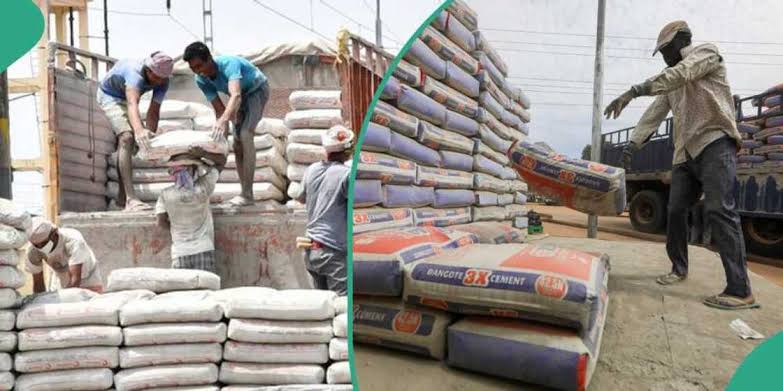The combined effects of the ongoing depreciation of the Naira and rising inflation have led to a significant 121% increase in the cost of cement production, raising concerns among Nigerians hoping for a reduction in the price of the essential building material.
With the cost of cement already high, smuggling to neighboring countries where prices are even higher has exacerbated the problem.
In countries like Chad and Cameroon, the cost of a 50kg bag of cement ranges between $120 and $150.
When converted at an exchange rate of ₦1,600 per dollar, this translates to a price between ₦240,000 and ₦270,200 per bag, significantly more expensive than the local price of ₦8,000 in Nigeria.
This disparity in prices has fueled smuggling activities, further reducing the availability of affordable cement for local consumers.
Industry experts warn that without targeted intervention, the hope of lower cement prices in Nigeria may remain elusive as production costs continue to rise.
Confirming this development, Kabiru Rabiu, Group Executive Director, BUA Cement, said, “One of the pressures that we see is that there is a lot of illegal smuggling of export of cement to Cameroon and Chad. What happens is that if you take cement just across the border to some of these markets, it is selling at $150 to $270. That is why we realize that a lot of our cement is actually not only going to the North East but to Maiduguri in particular because there are a lot of distributors taking this cement across borders because it offers a lot of margin.”
Vanguard analysis of the financial performance of the top three leading cement manufacturers revealed a decline in profitability due to rising cost of production.
The companies are Dangote Cement Plc, Lafarge Africa, and BUA Cement Plc.
Specifically, the combined revenue of the three top cement manufacturers grew by 84.5% to ₦1.116 trillion in Q1’24 from ₦604.9 billion in the corresponding period Q1’23.
The rise in revenue was, however, overshadowed by a 121% spike in combined production cost to ₦586.6 billion in Q1’24 from ₦264.9 billion in Q1’23.
As a result, the combined Profit Before Tax, PBT fell by 4.1% to ₦196.4 billion from ₦204.8 billion.
The National Association of Block Moulders of Nigeria (NABMON) has urged the Federal Government to reduce import duties on cement manufacturing components to attract more foreign investment in the sector.
The National President, NABMON, Mr Adesegun Banjoko, gave the advice, saying “the price of one bag of cement in Nigeria, currently in the region of ₦8,000 and ₦9,000 was still considered too expensive.”
Speaking to Financial Vanguard on condition of anonymity, a top official of Lafarge Africa Plc, makers of Elephant Cement stated that the operating environment has not been favourable to the cement industry as input costs continue to soar on a daily basis. The source noted that the cost for the importation of the machine and its parts for maintenance have been rising due to exchange rate volatility.
The source emphasised that the rise in inflation is also a concern to the industry, urging the government to quickly address the problem.
Another factor for the rise in the price of cement is the rising cost of energy.
“The machines that are used in the cement industry consume gas and electricity supply is erratic and cannot be relied upon,” the source added.
Concerning the threat by the government to lift importation of cement, Lafarge source said: “It is not the best option; the government should tackle the causes for inflation and provide the necessary infrastructure for production.”
Commenting on cost of inputs used by the cement manufacturers, Kabiru Rabiu, Group Executive Director, BUA Cement, said, “If you look at production costs the mining cost is probably not more 30% and that is the only thing that is local, but for instance, the energy cost is about 40 to 50% and is index to dollars.
“The price of gas that used to operate the cement plant actually went up a little bit; but it was not even the price that was the problem, it is more about the exchange rate, even though we pay in naira for the energy for the gas. What happened was that this gas was indexed to the US dollar. For example, last year we paid gas at ₦418 and then it jumped up to ₦750 and today the last invoice was priced at ₦1500.
“Also we all import our gypsum, yes in Sokoto, we use local gypsum, but we do import our gypsum which is also priced in US dollar and you clear it using dollar as a benchmark and then you transport it to your site. The bag in which we put cement also is in dollars because we import polypropylene as well; as the exchange rate of dollars continues to rise, this price will continue to go up. So it is perception that actually has been created that 90% of cement is local. The reality is even though you could say so, but the reality is that everything is indexed to dollars. The more the naira gets weaker the higher you see some of these input costs in our operation and unfortunately somebody has to bear the price.”






Leave a Reply